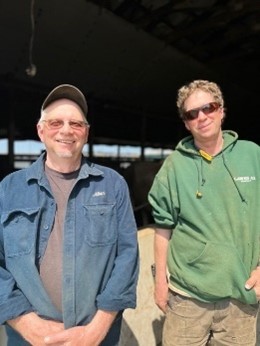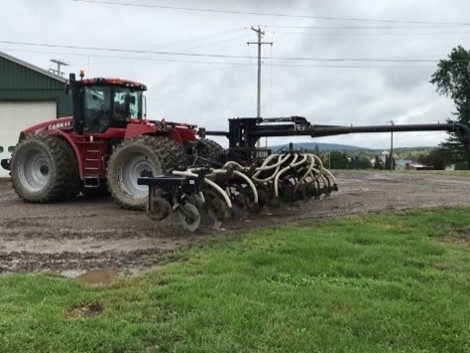By Sarah M. Audet, Champlain Valley Farmer Coalition


Dairy farmer Allan Brisson of Allandra Farm in Ferrisburgh is a manure injection evangelist. He’ll share the good word about this agriculture practice to anyone who will listen.
“I basically preach it–I don’t know why. I guess it’s because I’m passionate about it,” explains Allan. “It works so well and we all should be working in that direction.”
Allan uses a dragline manure injection system. He connects a hose to a pump at his manure pit and connects the other end of the hose to the manure injector attached to his tractor. As he drives across the field, disks akin to pizza cutters create slits and the manure is injected 3.5” into the soil. By injecting rather than broadcasting the manure, Allan reduces nitrogen loss, phosphorus run-off, and unpleasant odors.
When I visited with Allan on his 2500-acre, 1000-cow farm in May 2023, he and his son Michael were busy making round bale baleage. Following many days of cold, rainy weather, the sun was finally shining and the wind had shifted to the north. Their fields were drying out nicely, just in time for corn planting.
But what about injecting manure?
“We don’t inject in the spring because it makes the soil too wet,” Allan explains. “Much of the injection happens in the summer or fall.”
Four years ago, following two successful seasons of injecting manure on corn land, Allan and Michael wondered if the practice would work on grass, too. They tested it on two acres.
“We were just amazed,” says Allan. “When you’re injecting, you’re going slow, so it doesn’t disturb the soil so much.” Minimizing soil disturbance is the key to its health; soil that is overly worked is susceptible to erosion and nutrient run-off.
And it’s not just the soil that’s healthier–it’s the grass, too.
“The grass doesn’t like to get pooped on either,” Allan says with a laugh. “It’s not happy for a few days. Manure burns it.”
Six weeks following manure injection, Allan and Michael find they have a hearty grass crop with 20% protein.
“It helps us save a ton of money and increases the quality of our feed,” observes Allan. “We went from being an operation that typically was looking to buy feed to an operation that has feed to sell.”
He attributes much of his money savings to the decreased loss of nitrogen.
“When you spread manure on top of the ground, I think it’s a given you lose 80% or more of the nitrogen to the air,” Allan explains. “If you can smell manure being spread, the farmer is losing fertilizer value. When you inject, you cut the smell down by 90% and therefore you’re conserving your nitrogen.”
Allan estimates that if he were to resume spreading manure instead of injecting it, he would have to apply 200 pounds of urea in order to achieve that same 20% protein in his grass. Urea costs around $100 per acre; multiplied across 1000 acres, that is $100,000 in savings.
He acknowledges manure injection does not result in any fuel or labor savings for him, however.
“Anything more you do, takes a little more labor and management,” Allan notes. “But I think the quality of feed is a good return. Last year, we were able to save 60 cents per cow per day on rations. When you multiply that by 900 cows, that’s $540 in savings each day. That’s suddenly $190,000 per year.”
What has pushed Allan to try new things out of his comfort zone?
“I enjoy clean water as much as anyone–the beauty of Lake Champlain, a clean river. It’s just not ok to violate it,” he says. “So you figure out a better way to do something that’s not only good for the environment, it’s also good for you. It can’t get any better than that, can it?”

